TL;DR:
- Nvidia’s dominance in AI is challenged by AMD’s advancements in GPU technology.
- AMD is strategically positioned to offer cost-effective alternatives to Nvidia’s GPUs.
- AMD’s Instinct GPUs showcase competitive performance and pricing compared to Nvidia’s offerings.
- Tech giants are already exploring AMD’s Instinct GPUs for data center solutions.
- AMD’s comprehensive portfolio, including Epyc server CPUs and programmable chips, strengthens its position in the AI market.
- While AMD shows promising growth, Nvidia’s entrenched position suggests continued leadership in AI.
Main AI News:
In the realm of Artificial Intelligence (AI) powerhouses, Nvidia has reigned supreme for years. Its high-end data center GPUs have become synonymous with processing machine learning and AI tasks, propelling the company into a hypergrowth trajectory. Leading AI players such as OpenAI, Google, Microsoft, and Amazon all rely on Nvidia’s GPUs, cementing its position as the go-to choice in the industry.
However, as Nvidia enjoys its first-mover advantage with a lack of significant competitors, a formidable challenger emerges in the form of Advanced Micro Devices (AMD). Traditionally known for its presence in the gaming GPU market, AMD has set its sights on the AI sector. The question arises: Could AMD potentially overthrow Nvidia as the frontrunner in AI chip technology?
The Dynamics of the AMD-Nvidia Rivalry
AMD’s foray into the GPU market began with its acquisition of ATI in 2006, a move aimed at challenging Nvidia’s dominance. Expanding ATI’s Radeon brand, AMD entered the realm of discrete GPUs for gaming PCs and subsequently ventured into creating Accelerated Processing Units (APUs), combining CPUs and GPUs on a single die for PCs and gaming consoles.
In its battle against Nvidia, AMD’s strategy mirrored its approach to competing with Intel in the CPU market: offering chips at more competitive price points. While AMD GPUs often matched Nvidia’s gaming performance, they typically consumed more power due to less efficient designs. Despite its efforts, Nvidia maintained a stronghold, commanding about 80% of the discrete GPU market, leaving AMD a distant second with a 17% share, as per Jon Peddie Research.
The Advantages of AMD in the AI Arena
Unlike Intel, which predominantly manufactures its chips in-house, both AMD and Nvidia rely on outsourcing production to Taiwan Semiconductor Manufacturing (TSMC). This common ground suggests that AMD might have a fair chance of catching up to Nvidia in the AI domain. Over the years, AMD has launched several iterations of its Instinct GPUs, leveraging advancements in fabrication technology, including the latest 5nm and 6nm nodes from TSMC.
Recent industry benchmarks indicate promising results for AMD’s top-tier MI300X GPU, surpassing Nvidia’s H100 in terms of raw processing power and memory bandwidth, crucial metrics for AI tasks. Moreover, the price point further tilts the scale in AMD’s favor, with four MI300 GPUs available for the price of a single Nvidia H100, which often exceeds $40,000 due to supply chain challenges faced by Nvidia.
Despite Nvidia’s claims of superior performance with optimized software, the substantial price gap coupled with persistent supply chain constraints could sway more customers towards AMD’s offerings. Already, tech giants like Microsoft, Meta Platforms, Oracle, Dell, and Hewlett Packard Enterprise have begun exploring AMD’s Instinct GPUs as cost-effective alternatives to Nvidia’s solutions.
AMD’s Strategic Positioning for Growth
In addition to its Instinct GPUs, AMD’s portfolio includes Epyc server CPUs, competing directly with Intel’s Xeon CPUs, and programmable chips acquired through its purchase of Xilinx. This comprehensive suite enables AMD to offer bundled solutions for data centers, combining performance and cost-efficiency.
During AMD’s recent fourth-quarter conference call, CEO Lisa Su highlighted the accelerating deployments of MI300 GPUs, indicating a robust revenue trajectory. With a significant portion of its revenue attributed to data centers and embedded chips, including Epyc, Instinct, Xilinx, and gaming APUs, AMD has demonstrated substantial growth potential in the AI market.
While AMD’s market share in the global data-center CPU market has shown steady growth, rising from 12% in 2021 to an estimated 25% in the past year, surpassing Nvidia as the undisputed leader in AI remains a formidable challenge. Nvidia’s ability to stabilize prices amidst supply chain disruptions, coupled with the tendency of data center operators to diversify chip sources, suggests that AMD will likely carve out a lucrative niche in the AI market without dethroning Nvidia.
Conclusion:
AMD’s advancements in the AI market signify a significant shift in the competitive landscape, challenging Nvidia’s long-standing dominance. While AMD’s progress is notable, Nvidia’s established presence and market dynamics suggest that it will maintain its leadership position in the foreseeable future. However, AMD’s ability to carve out a lucrative niche and provide cost-efficient alternatives will contribute to a more diversified and competitive AI market, offering customers a wider range of choices and driving innovation in the industry.

